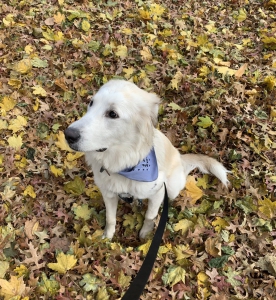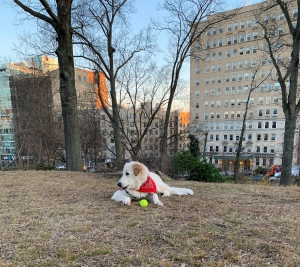5 tips to maintain a daily exercise routine during isolation
This is the first of a two-part series on wellness in the era of COVID-19. Next week we’ll run another piece on maintaining mental well being.
I’m so glad I have a dog!
My dog, Daisy, insists on a morning trip to the park every day. And since I’ve started working from home regularly, there’s really no reason we can’t spend a good hour there every morning.
We live in Brooklyn, which is, of course in New York City — the largest cluster of coronavirus in the United States. And, although the disease is causing havoc in the community, it’s still important to take steps to ensure our physical and mental well being.
Which is where Daisy comes in.

Daisy and I head to the dog park every morning at around 7. We return at about 8, which gives me enough time to shower, get dressed, make breakfast, and be ready to start working at 9 am.
I am very grateful for this daily ritual! Because if it weren’t for Daisy, there’s a decent chance I’d never go outside.
Life in the time of Corona
We find ourselves in a new era.
As of Friday, March 27, more than 216 million Americans have been advised to stay at home — a number that’s certain to rise.
And, according to most projections, it’s not going to change anytime soon. Many experts believe this period of social distancing must last for 1-3 months, at a minimum. Andrew Noymer, a public health professor at the University of California at Irvine, gave this quote to The Atlantic in an article that was published on March 26.
“Prematurely ending severe social distancing would be an incredible blunder that would have major human consequences. […] What is ‘prematurely’? The truth is, we don’t know yet, exactly, but it’s longer than a fortnight. It could be eight to 12 weeks.”
Noymer’s estimated timeframe of 2-3 months could be the low end, compared to some other estimates. Alternatively, a widely-discussed modeling study from the Imperial College of London points to a social distancing period of 12-18 months, until a vaccine could be developed.
These estimates are not meant to frighten anyone, but rather to help us understand what we are up against. Once we have a clear picture of what to expect, we can start to plan against it.
As we make our contingency plans for the next few months, I’d advise you to take your own personal physical fitness into consideration. Since we know this situation will last, it’s time to adapt your routines and ensure you’re doing what you can to keep your body in the best shape possible.
Finding a fitness plan that fits your life
The good news is that much of the fitness industry was already moving online. And while this pandemic is certainly giving a little more urgency to that transition, several resources already exist that can help meet you where you’re at on your fitness journey.
Whether you’re a runner, a weightlifter, a yoga enthusiast or someone who’s just starting out, here’s a curated list of resources that can help you make the best of this situation. And who knows, maybe you can form a new healthy habit that will follow you through this current period of uncertainty!
- Yoga with Adriene: Come for the YouTube yogi that thousands of Americans swear by. Stay for the off-chance that her blue heeler Benji walks into the shot.
- Cycling: With public transit ridership decreasing dramatically, people are turning to the humble bicycle to get from here to there. In New York City, bike crossings of the East River shot up 52 percent compared to last year.
- Download an app: There’s a lot you can do at a local park or within the comfort of your own home, from kickboxing to Pilates and everything in between. Aaptiv, Asana Rebel, Daily Burn, Fitbit Coach, Peloton and Nike Training Club are a few that come to mind.
- In-Home Workouts: Many local gyms offer live group fitness sessions over Instagram Live — now could be a great opportunity to work out with an instructor with a motivating foreign accent!
- Running: Certainly nothing against running! I wait until late at night to run my laps at Prospect Park when fewer people are out. And if you’re the type of person who prefers a plan, check out Hal Higdon.
Everything, of course, is dependent on your situation and your abilities. If your knees aren’t going to let you run, maybe the bicycle is a good option for you. If your kids won’t let you escape for that long, maybe you can get them to join you for a game of tag in the backyard.
Your mileage will vary, as they say — but the important thing is to start that journey and find something that works for you. This could be a great opportunity to flatten your curves while also flattening the curve.
Conclusion
When the workday ends, Daisy and I go right back out to the park. Sometimes she brings her tennis ball in her mouth — other times, she carries her Frisbee.

When we arrive at the dog run, I take her off her leash and let her play with her friends. While she’s doing that, I do laps around the park. (Usually, I walk, but if I’m feeling ambitious, I jog.) I do pushups and dips on the park benches.
The other dog owners and I visit with one another — from a safe distance, of course! We chat about the joys and struggles of being cooped up at home and share recipes.
We all feel the sun on our skin and the fresh air in our lungs. And as long as we’re assiduous about following CDC guidelines (keeping your distance from other people, washing your hands, not touching your face) — our risk is minimal. And, at least for me, the benefits of staying active are an excellent way to maintain contact with the outside world.
Because, as Tom Hanks would say in You’ve Got Mail, it’d be a shame to miss New York in the spring.
About the author
Andrew Winner is a learning & development consultant with Synergis. He has 15 years of experience and attended the University of Washington, Boise State and Gonzaga. He lives in Brooklyn with his dog, Daisy.
Share this article
Let's get started.
"*" indicates required fields
